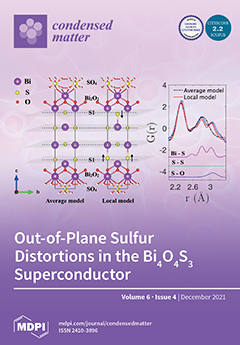Cerium oxides (ceria) are materials that exhibit weak, room-temperature ferromagnetism without
d-electrons. The latter are usually responsible for magnetism in a variety of other oxide compounds, but the underlying mechanism for such a magnetic response in ceria without the
d-electrons (
[...] Read more.
Cerium oxides (ceria) are materials that exhibit weak, room-temperature ferromagnetism without
d-electrons. The latter are usually responsible for magnetism in a variety of other oxide compounds, but the underlying mechanism for such a magnetic response in ceria without the
d-electrons (
-magnetism) is still under debate. A possible explanation is Zener double-exchange, where itinerant electrons polarize the localized spins via Hund-coupling as they hop from site to site. Here, we report magnetization and spin-spin correlation results using various values of the Hund-coupling in a one-orbital double-exchange model with Ising spins. In the real material with formula CeO
, the oxygen-deficient sites are denoted by
x. These sites are related to the density of tetravalent cerium spins (the Ising spin background in our model), which we denoted as and set at
in our simulations. Our results at this value of localized spin concentration show ferromagnetic tendencies at low carrier densities (
). However, ferromagnetism is lost at intermediate carrier concentrations (
due to charge localization at high temperatures, as evident from density of states calculations and Monte Carlo snapshots. To our knowledge, our study based on a realistic Zener-type double exchange mechanism is a first in the study of magnetism in cerium oxides. Our results are also consistent with previous studies using similar Hamiltonians in the context of diluted magnetic semiconductors, where Heisenberg spins were used.
Full article





